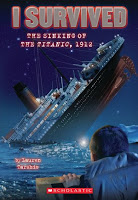Kaspar the Titanic Cat, written by Michael Morugo and illustrated by Michael Foreman, 200 pp, RL 4
Having been a children's bookseller for almost seventeen years now and a parent for a couple of years longer, I have seen many children, including my own, express a fascination with the story of the Titanic. Like other seemingly frightening and/or dangerous things that small children are fascinated with (sharks, dinosaurs, bugs) they grasp the literal enormity of the thing but don't yet grasp the emotional enormity of that which they are drawn to. Kids can't really fathom what it must be like to be hunted by a T-rex or a shark, nor do they grasp the tragedy and needless loss of life that resulted from the hubris of the builders of the "ship that couldn't sink." Kaspar the Titanic Cat was difficult for me to read and I had to put it down more than once, but I know that how I read this book and how a child reads it are different. In fact, I had the good fortune to speak with a second grader who had just finished reading this book and I asked her if it made her sad at all. A head shake "no" was the answer, and rightly so, I suppose. However, in his newest book, Michael Morpugo, author of War Horse, finds a way to portray the suffering and loss of life that was part of this disaster, weaving an uplifting story around it. Michael Foreman's illustrations are realistic but softened with and even sometimes playful and add a valuable dimension to the story of Kaspar the Titanic Cat.
 While Morpugo's story impacted me, reading his author's note that comes at the end of the book gave the story a historical anchor beyond the event that was the sinking of the Titanic as well as a nice twist to the tale. While Kaspar the cat is the center of this book, young Johnny Trott, fourteen-year-old orphan and bellboy at the Savoy Hotel in London is the main character and narrator of Kaspar the Titanic Cat. The first half of the book tells the story of how Kaspar ended up at the Savoy and how Kaspar and Johnny find themselves on board the Titanic as it sails from Southampton. The book begins, "Prince Kaspar Kandinsky first came to the Savoy Hotel in a basket. I know because I was the one who carried him in." Prince Kaspar is the pet of Countesss Kandinsky, a Russian opera singer who will be performing Mozart's Magic Flute at Covent Garden. Being a prince, Kaspar has particular demands and, being one of the few people in the world he does not dislike, it is Johnny Trott who takes on the task of attending to him. And in turn, the Countess grows fond of Johnny, buying him a suit and a seat at her performance. Johnny has often fantasized about the real mother he never knew and begins to look to the Countess with the same fondness. This makes the death of the Countess even harder to bear when she is struck down by an omnibus. Johnny watches as Kaspar refuses to eat and wastes away while awaiting the Countess's family to arrive in London and collect her belongings. At great risk to his job and home, all the servants live in the Savoy and work long hours, Johnny sneaks Kaspar into his small attic room.
While Morpugo's story impacted me, reading his author's note that comes at the end of the book gave the story a historical anchor beyond the event that was the sinking of the Titanic as well as a nice twist to the tale. While Kaspar the cat is the center of this book, young Johnny Trott, fourteen-year-old orphan and bellboy at the Savoy Hotel in London is the main character and narrator of Kaspar the Titanic Cat. The first half of the book tells the story of how Kaspar ended up at the Savoy and how Kaspar and Johnny find themselves on board the Titanic as it sails from Southampton. The book begins, "Prince Kaspar Kandinsky first came to the Savoy Hotel in a basket. I know because I was the one who carried him in." Prince Kaspar is the pet of Countesss Kandinsky, a Russian opera singer who will be performing Mozart's Magic Flute at Covent Garden. Being a prince, Kaspar has particular demands and, being one of the few people in the world he does not dislike, it is Johnny Trott who takes on the task of attending to him. And in turn, the Countess grows fond of Johnny, buying him a suit and a seat at her performance. Johnny has often fantasized about the real mother he never knew and begins to look to the Countess with the same fondness. This makes the death of the Countess even harder to bear when she is struck down by an omnibus. Johnny watches as Kaspar refuses to eat and wastes away while awaiting the Countess's family to arrive in London and collect her belongings. At great risk to his job and home, all the servants live in the Savoy and work long hours, Johnny sneaks Kaspar into his small attic room.  It seems that Kaspar might actually die of his broken heart when an American family with a very rambunctious little girl arrives. Johhny comments that, unlike most American visitors, the Stantons seem reserved and aloof, although their seven-year old daughter Lizziebeth makes up for this. Constantly running off and exploring the hotel on her own, the staff if often asked to locate her. One day Johnny finds her in his room, petting and feeding Kaspar, who seems to be perking up. From there on out, Johnny, Lizziebeth and Kaspar are fast friends. When Lizziebeth climbs out onto the ledge of the window in Johnny's room to rescue a wounded pigeon, he is there to coax her back inside safely and rewarded generously by her parents. Johnny begins to feel like he might have a chance at a bright future. However, Skullface, the cruel head housekeeper, takes it from him with threats of losing his job if he complains. Johnny keeps it to himself, but in the end, with the departure of the Stantons not far off, he shares this sad turn of events with Lizziebeth. As a final gesture of thanks, the Stantons employ Johnny to accompany them to to Southampton and load their baggage onto the Titanic. Lizziebeth convinces them to bring Kaspar along for the ride and one last goodbye.
It seems that Kaspar might actually die of his broken heart when an American family with a very rambunctious little girl arrives. Johhny comments that, unlike most American visitors, the Stantons seem reserved and aloof, although their seven-year old daughter Lizziebeth makes up for this. Constantly running off and exploring the hotel on her own, the staff if often asked to locate her. One day Johnny finds her in his room, petting and feeding Kaspar, who seems to be perking up. From there on out, Johnny, Lizziebeth and Kaspar are fast friends. When Lizziebeth climbs out onto the ledge of the window in Johnny's room to rescue a wounded pigeon, he is there to coax her back inside safely and rewarded generously by her parents. Johnny begins to feel like he might have a chance at a bright future. However, Skullface, the cruel head housekeeper, takes it from him with threats of losing his job if he complains. Johnny keeps it to himself, but in the end, with the departure of the Stantons not far off, he shares this sad turn of events with Lizziebeth. As a final gesture of thanks, the Stantons employ Johnny to accompany them to to Southampton and load their baggage onto the Titanic. Lizziebeth convinces them to bring Kaspar along for the ride and one last goodbye.
How Johnny and Kaspar end up on the ship and how they spend the five days before she sinks are intersting. In the chapter titled, "Women and Children First," Morpugo tells the story of how Johnny first learns of the breach in the ship and how he alerts the Stantons, who had no idea he was on the ship. As he and Mr Stanton see Lizziebeth and her mother safely onto a lifeboat, Johnny knows he must return to their room and rescue Kaspar, whom Mr Stanton insisted be left behind. The next chapter, "Good Luck and God Bless You," tells the harrowing story of the sinking of the great ship and how Mr Stanton and Johnny fare as well and how others die. One of the most painful parts to read finds Mr Stanton and Johnny clinging to a canvas lifeboat in the freezing sea. Of reaching and being pulled onto the boat Johnny says,
Only then did I really begin to take in the horrors of the tragedy I had been living through. The shrieks and the cries of the drowning were all around me. I caught my last sight of the great Titanic, her stern almost vertical, slipping into the sea. When she was gone, we were left only with the debris of this dreadful disaster strewn all around the ocean and those terrible cries that went on and on. And there were swimmers in the sea all around us, every one of them, it seemed heading our way. Very soon we were swamped with them, and we were turning them away, yelling at any other who came near that there was no room. And that was true, horribly true.
When he has to turn away a swimmer, a man he knew, Johnny says, "I will carry to the grave the guilt of what I did to that man and to many others."
Although the sinking of the ship makes up only two of the ten chapters in the book - there is a final chapter where we learn the fates of the Stantons, Johnny and Kaspar that is very rewarding - they made an impact on me as a reader. What the target audience, presumably 8 - 12 year olds, make of it, I am curious to know. In this year that marks the 100th anniversary of the sinking, Kaspar the Titanic Cat is a story that focuses on the individuals, who, while fictional are representative of the various classes and cultures that were on the Titanic, and gives a human side to the story that might help younger readers begin to grasp the full weight of this maritime disaster. By adding a sleek black cat to draw you in to the story, Morpugo brilliantly finds a way to reach a larger audience and encouraging empathy from readers who might just be discovering this human quality.
The Real Savoy Hotel and the real (statue) of Kaspar.
Other Titanic fiction and non-fiction you might like:
FICTION
NON-FICTION

















